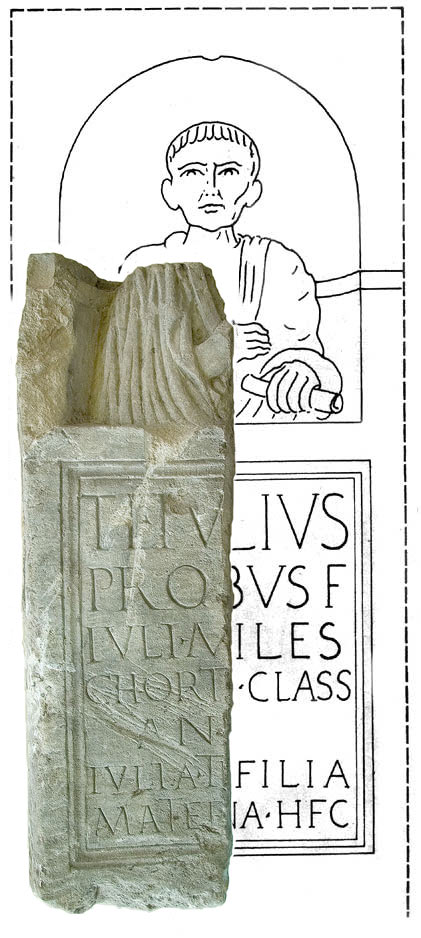Fectio
Index






|
|

click here
|
Roman Stone 
Wednesday 31
March 2004 |
Houten
Roman Stone |
  |
Roman
name: -
Roman Province: Germania Inferior
Country: The Netherlands
Province: Utrecht
Nearest town: Utrecht
Nearest village: Houten |

Houten from the air in 1997. 1 is the find-spot, 2 is the town hall.
|
In the
spring of 2000, a surprise find was made in the town of
Houten, which lies roughly to the SE of Utrecht. During
the building of a cycle-tunnel under the Utrecht-Den
Bosch railwayline, an amateur archaeologist by the name
of Ben Elbertse found the remains of a Roman funeral
stone. The earth from this development was dumped
elsewhere, after which Mr Elbertse made his spectacular
find.
By itself this was no surprise because this area, which
lies close to the old Roman border and just a few miles
from the castellum Fectio, was already known for
the existence of several Roman villas. However, apart
from some small finds, there had never been anything like
a gravestone found in the area.
The
stone measures about 85x25x20 cm and was clearly cut in
half during Roman times, possibly for re-use in a nearby
villa. The remaining 40% of the stone shows part of a
text and roughly a third of the figure of the deceased.
The text on the stone can be reconstructed as:
T.IV(LIVS)
PRO(BVS F)
IVLI.M(ILES)
CHORT.(I.CLASS)
. . . .A N
IVLIA.TI.(FILIA)
MATER(NA.HFC) |
Tiberius Iulius
Probus, born in
Forum Iulii, soldier
of the 1st cohort Classica,
in the age of ? years (lies buried here).
Iulia Materna, daughter
and heir of Tiberius had this made. |
This construction was based on a
comparison by A.M.J. Derks (Vrije Universiteit Amsterdam)
with similarly styled stones from the Rhineland around
Cologne (Köln). Such stones had a rough 'foot', a piece
of text and a niche with a bust of the dead. The text is
also based on educated guesswork with that sort of stones
in mind. Such monuments are dated between 25 and 50AD,
and just two more are known from The Netherlands. The
original stone may have measured 150x50x20 cm and may
have stood in the garden of a villa.
 Who was this
Tiberius Julius Probus? Apparently he was a soldier, born
as far a way as the south of France (Fréjus/Provence),
serving in the auxiliary cohort called I Classica. This
unit was raised by Augustus from soldiers of the fleet,
and apparently it was moved to Fectio longer
before the Batavian uprising in 69-70 AD then was
originally thought. He is clearly wearing a toga, holding
the hem with his right hand and probably holding a scroll
with his missing left hand. This shows he was a Roman
citizen, which complies with what we know of this unit,
which was raised entirely from Roman citizens. Who was this
Tiberius Julius Probus? Apparently he was a soldier, born
as far a way as the south of France (Fréjus/Provence),
serving in the auxiliary cohort called I Classica. This
unit was raised by Augustus from soldiers of the fleet,
and apparently it was moved to Fectio longer
before the Batavian uprising in 69-70 AD then was
originally thought. He is clearly wearing a toga, holding
the hem with his right hand and probably holding a scroll
with his missing left hand. This shows he was a Roman
citizen, which complies with what we know of this unit,
which was raised entirely from Roman citizens.

The find-spot in the spring of 2000. |

The stone, shortly after its recovery. |

Close-up of the text. |

Close-up of the stone. |

Marrit (7) next to the stone. |
The
visit
I work
for the council of Houten for some time now, and all
along the stone had been kept in the town hall inside a
glass case on the ground floor near the entrance.
Suddenly it had vanished, luckily to re-appear again on
the second floor, as it happened very close to where I
work. The reason for this was the upcoming overhaul of
the complete ground floor, although that meant
withdrawing it from the public eye. Visitors will still
have access to it when they ask to see the stone at the
reception desk. I think I like it better this way - I can
see it every day now!
Anyway, I had my daughter visiting my working place and I
could not resist shooting some pictures..
Bibliography 
- Krijg nou wat. Dit
is écht bijzonder/Wie was Tiberius Iulius de
Brave?, Utrechts Nieuwsblad, 24 mei 2000.
- Het Graf van
Tiberius Iulius Probus, NRC Handelsblad, 27 mei
2000.
- Bijzondere
Grafsteen gevonden, 't Groentje, 31 mei 2000.
- ROB (2002): Houten,
het Kasteel, de Put en het Paard, Op zoek naar de
geschiedenis in het landschap, Archeologische
Routes in Nederland 37.*
|